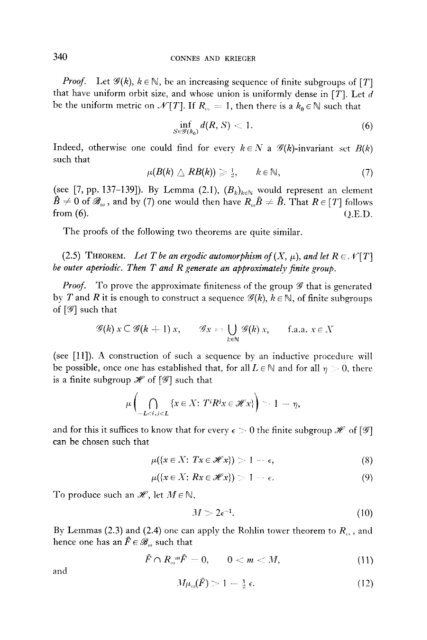Extension Theorems of Hahn-Banach Type for Nonlinear Disjointly ...
Extension Theorems of Hahn-Banach Type for Nonlinear Disjointly ...
Extension Theorems of Hahn-Banach Type for Nonlinear Disjointly ...
You also want an ePaper? Increase the reach of your titles
YUMPU automatically turns print PDFs into web optimized ePapers that Google loves.
340 CONNES AND KRIEGER<br />
Pro<strong>of</strong>. Let Y(a), Ii E N, be an increasing sequence <strong>of</strong> finite subgroups <strong>of</strong> [Y]<br />
that have uni<strong>for</strong>m orbit size, and whose union is uni<strong>for</strong>mly dense in [T]. Let d<br />
be the uni<strong>for</strong>m metric on ./lr[?“]. If R,,, =: 1, then there is a K, E N such that<br />
inf d(R, S) -: 1.<br />
StJ(k,)<br />
Indeed, otherwise one could find <strong>for</strong> every hen; a q(k)-invariant set R(k)<br />
such that<br />
(L@(k) A RB(k)) 2: 1, kEN> (7)<br />
(see [7, pp. 137-1391). By Lemma (2.1), (B,),,N would represent an clement<br />
2 -f 0 <strong>of</strong> -CZU , and by (7) one would then have R,$ =& a. That R E [T] follows<br />
from (6). Q.E.D.<br />
The pro<strong>of</strong>s <strong>of</strong> the following two theorems are quite similar.<br />
(2.5) THEOREM. Let T be an ergodic automorphism <strong>of</strong> (X, p), and let R E . V[T]<br />
be outer aperiodic. Then T and R generate an approximately finite group.<br />
Pro<strong>of</strong>. To prove the approximate finiteness <strong>of</strong> the group 9 that is generated<br />
by T and R it is enough to construct a sequence B(k), K E N, <strong>of</strong> finite s&groups<br />
<strong>of</strong> [Y] such that<br />
9(k)xC!qk + 1)x, Yx : : yN Y(k) .v, f.a.a. .I’ E zY<br />
(see [Ill). A construction <strong>of</strong> such a sequence by an inductive procedure will<br />
be possible, once one has established that, <strong>for</strong> all L E N and <strong>for</strong> all ? 0, there<br />
is a finite subgroup SC!? <strong>of</strong> [9] such that<br />
jL t<br />
-Lii.iCL<br />
n {X E s: TiRjs E XS:. ‘-. 1 --- ?l,<br />
and <strong>for</strong> this it suffices to know that <strong>for</strong> every E :, 0 the finite subgroup ,Z <strong>of</strong> [Y]<br />
can be chosen such that<br />
To produce such an 2, let )Ur E N,<br />
p({x ES: Tzc E 2x}) 3:. 1 -- t,<br />
p({x E X: Rx E 2.~)) : I t.<br />
i<br />
(6)<br />
(8)<br />
.;II ;- 2EC1. (10)<br />
By Lemmas (2.3) and (2.4) one can apply the Rohlin tower theorem to R,,, , and<br />
hence one has an P E g

















